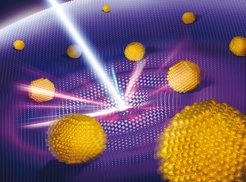Ultrafast Rotational Motions of Supported Nanoclusters Probed by Electron Diffraction
In the nanometer length-scale, structural stability is prone to ultrafast motions that range from atomic vibrations to translations and rotations of entire nanostructures. To study the rotational motions of entire nanoparticles, we establish femtosecond electron diffraction as goniometer of ultrafast nanocrystal rotations. To achieve our scope we have combined experiments that use ultrashort pulses of electrons and photons, with detailed simulations of molecular dynamics and electron diffraction.
Nanotechnologies utilize physical and chemical properties which arise by shrinking a material in size to the nanometer length scale. The structural stability of nanoscale building blocks is a central aspect in nanoscience as it governs the long-term stability of a device. Function, however, is only achieved once a device is energized, which is why nanotechnologies require materials which are structurally stable under operation conditions.

On the atomic level, the structure is prone to ultrafast motions that range from atomic vibrations and diffusion to translations and rotations of entire nanostructures. These motions, for instance, governs the sintering of nanoparticles to larger complexes which occurs at elevated temperatures. To study the motion of entire nanoparticles, we establish femtosecond electron diffraction as goniometer of ultrafast nanocrystal rotations. We have investigated nanoclusters containing 923 gold atoms, which have been deposited on a graphene sheet, with ultrashort pulses of electrons. We observe motions of the atoms in the cluster as well as constrained rotations, so-called librations, of the entire nanoclusters. This motion is induced by suddenly energizing the material, which is realized by illumination with an ultrashort laser pulse.
These experiments are compared to molecular dynamics and electron diffraction simulations. Through the combination of the different approaches, the mechanism for the conversion of laser energy to rotational motions could be revealed. This study adds a new aspect to the understanding of nanoscopic heterostructures in out-of-equilibrium conditions and to the mechanisms of heat- and mass-transport in nanoscale materials.
This research results from an international collaboration between the research group Structural & Electronic Surface Dynamics at the Fritz Haber Institute in Berlin headed by Ralph Ernstorfer, the group of Richard Palmer at Swansea University in the UK, and the group of Vlasios Mavrantzas located at the University of Patras (Greece) and the ETH Zurich. This project was supported from the European Union through the ERC grant FLATLAND.












